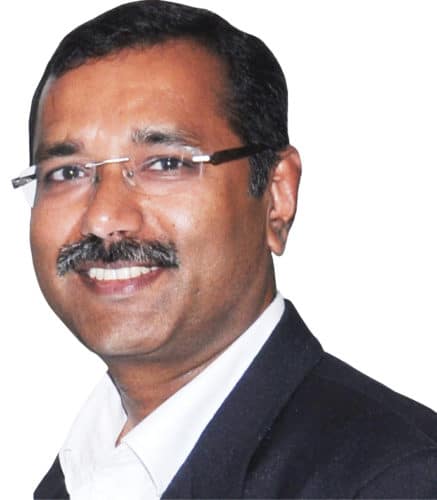Why is a tech giant like Unisys investing in a college-level competition for the last twelve years? What’s in it for them? And, how did they manage to continue to hire despite the pandemic? Electronics For You spoke to Ravi Shankar Ivaturi, senior director, business operations, Unisys, to find answers to these questions, and here are the excerpts.

Q. Why is Unisys investing in such a competition?
A. Cloud 20/20 is celebrating its 12th year now, and Unisys has been known for innovation for over 140 years for building high-performance and security-centric solutions for large enterprises and governments. Unisys is a core technology company. When we started in India, at that time there were only a few such companies in the market. So, we believe that as we are a part of the ecosystem, it is our duty to take leadership and bring the ecosystem together to deal with problems and challenges such as business models, changing trends, etc, through innovation.
For starters, we know that in India, we have some brilliant students with brilliant minds. But when it comes to being in a job, we found out that the students these days are not job ready. To bridge this gap, we thought of coming up with this contest that would serve as a stepping stone for the students into the professional world.
Q. How is the ecosystem contributing to it? In what aspect are they contributing?
A. Talking about academia, we invite students from engineering colleges to submit project ideas. These teams include professors and students. Shortlisted project ideas are further developed into demonstrable POCs (proof of concept) with the help of Unisys mentors. Within Cloud 20/20, we have two different programmes for students:
SIP (Student Innovation Programme): Here, we allow the students to define their own problem statements in various fields such as government, taxation, securing the Internet, securing railways, etc.
TIP (Targeted Innovation Programme): Here, we along with our clients and partners work on a single (or multiple in some cases) business-specific problem statements. Then it is released in public, and students who want to work on these problem statements can apply.
We get entries from across the country, and the best teams are selected to present their projects in an event held in Bengaluru. The panel that selects these teams comprises our trade bodies, someone from academia, and some of our clients to look at the idea from all the possible angles. This is how all the members in our ecosystem work on different/multiple levels to contribute towards the common goal.
Q. Involving clients into this process increases the chances of them adopting the idea of conducting a similar contest. How does this work? Do you have the confidence or a strong relationship to prevent this from happening?
A. First, let me share our definition of trust, which is competence and character. We approach our clients and partners for participation in the contest with clear guidelines laid out in terms of their roles, responsibilities, and takeaways. We are transparent and collaborative in our approach. Also, Cloud 20/20 is an 11-year-old platform with deep connects in academia. Our relationship with many of the participating institutes goes beyond this contest. We have full faith in the quality of the contest and the bond we have established with academia over the years.
Q. What happens to IP, especially in TIP? Is there an exchange of IP in such cases?
A. At the start of the relationship, when the students are registered, it is declared that the IP belongs to Unisys, as we are taking the lead in the ecosystem. Also, at the stage of funnelling down the teams, we make an explicit declaration that the IP belongs to Unisys. This helps in ensuring transparency. Talking about innovative ideas and their deployment, we talk to our clients and come up with a suitable decision as to where the IP belongs.
Q. Can you share any success stories where the solution has been given and implemented for a problem statement?
A. This is a new initiative, and we started functioning about two years ago. Though we have great partners and we had good problem statements as well. However, the solutions could not be implemented due to Covid-19. We are hopeful that in the years to come, a few of these solutions will be implemented.
Q. The name Cloud 20/20 was decided twelve years back. However, the programme was implemented two years ago. What was the thought behind the name? Was it because of the year or the IPL?
A. Almost everything that we do nowadays is based on cloud technology. Twelve years ago, we knew that this cloud system is going to be the future of technological developments. However, the 20 by 20 has nothing to do with the year or the IPL. In the western context, 20 by 20 means perfect eyesight, so by this programme and academia, we wanted to provide customers a clear vision of cloud and cloud-based services. Cloud is a metaphor for emerging technologies, and the programme 20 by 20 is also a driving force for us as we want to keep making it clearer.
Q. What came first the SIP or TIP?
A. SIP came first. Initially, it started as a technical paper contest. Then we shifted it to a demonstrable project contest, where the contestant needs to write an abstract, develop a prototype, and then demonstrate it to our technical panel. After this, we were questioning ourselves that what we can do next, and then we came up with the TIP part of the programme.
Q. The award money for SIP and TIP is 425,000 rupees, so how is it divided between the two different challenges?
A. The judgment is based on who provides a better solution to the problem and where will it be good to invest money. The money is awarded to three teams; the combination does not matter to us, but the kind of solution matters. In rarest cases, there is a tie between teams, and in such cases, we either split the money or introduce another award.
Q. How many of your employees get allocated to assist with the projects?
A. Roughly about five per cent of the employees are allocated to help with the projects. The engineers are not fully invested in the projects as their role is just to provide mentorship to the students and, in the end, the student has to complete it himself/herself.
Q. Besides this competition, any other platforms to engage with academia and students?
A. Yes, we do have a dedicated programme called UTFI, which can be accessed through the website called utfi.co.in. Through this, a student can apply for internships. This is the primary platform for our academia. Here we have uploaded some technical webinars, the latest technology trends, information about the contests, and other relevant information. This is not a charged service and anyone can access it.
Q. What are the challenges and opportunities that you are seeing during the pandemic regarding the hiring of candidates?
A. Our IT and recruitment teams worked really well during this pandemic, and they found out solutions very quickly to deal with the scenario. Now we interview candidates through digital mediums such as phone calls, interacting through video calls, learning through videos, etc. We were still hiring throughout the pandemic, and there was no change in the recruitment strategy, only the medium of recruitment was changed.
Q. Which kind of technology is expected to see a boom and which are the ones that are diminishing? Which technology would you suggest students bet on?
A. We believe in ‘Inch wide and mile deep,’ which means exploring all the possible technologies but, at the same time, understanding the core at a deeper level to become a thought leader in the subject. I think that there’s a lot of scope in the digital transformation sector and the adoption of cloud technologies. Also, the technologies that involve data analytics study to make better and informed decisions, and will help in making the consumer future-ready, are expected to survive in the future. All types of emerging technologies like Blockchain, AIML, IoT, etc, are the area that I can bet on.
Q. What happens to the content and white papers that are shared with you? Do you release it, publish it on the website, or Open Source it?
A. Yes, we share the winning ideas on our website and retain all entries on our internal website. The engineers that are responsible to mentor the students gather all the idea in one place. Then we publish these ideas on our internal website under the category ‘Cloud 20-20.’ This enables all the engineers in our company to read these ideas, comment on them, and later try evolving a combination of ideas to develop existing technologies. Second, we try to file patents wherever possible.
Q. The program 20-20 exists in other countries as well, or is it just an India driven initiative?
A. Originally, it is an India driven initiative, but we are looking forward to ways in which we can run this programme in other countries as well. So, in the future, you might see it as an internationally running programme.







